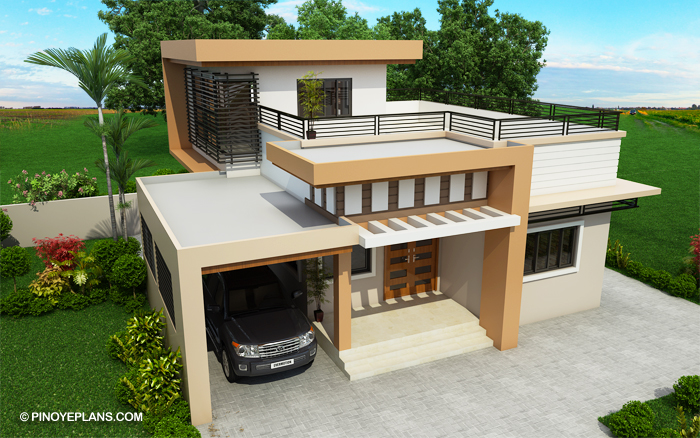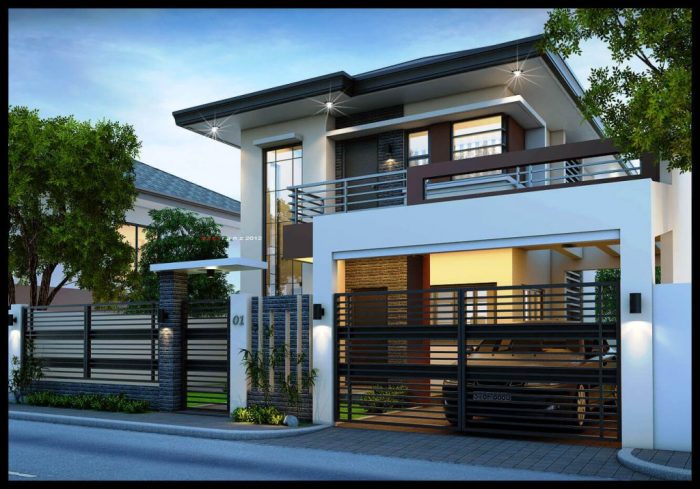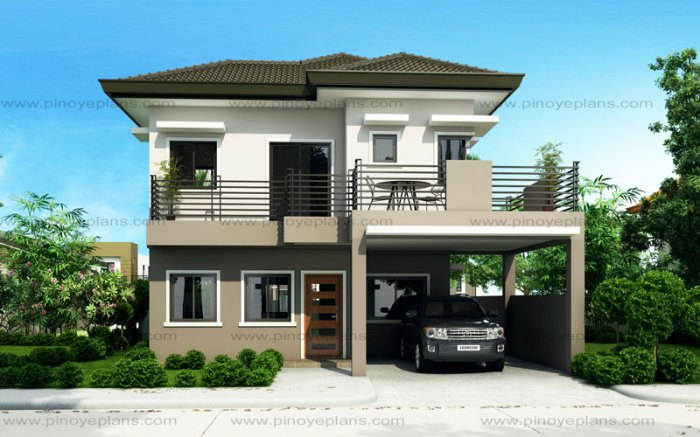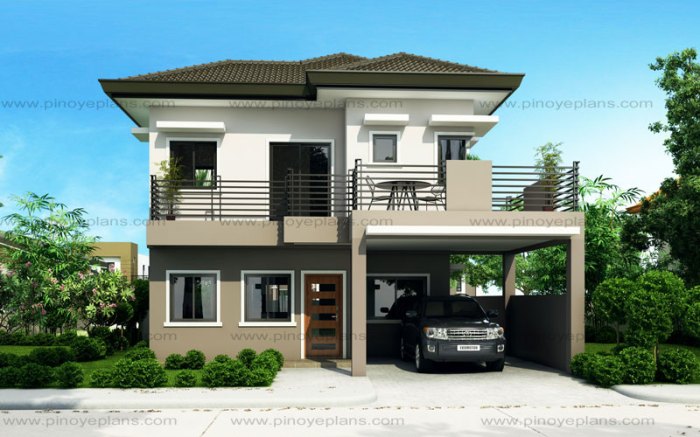2 Storey House Interior Design Philippines: Embracing Filipino culture and modern design trends, creating a comfortable and stylish home is a dream for many Filipinos. From the layout to the color palette, every detail reflects the unique lifestyle and values of the Filipino family.
This guide explores the essential elements of designing a 2-storey house in the Philippines, showcasing how to blend functionality with aesthetics and create a space that truly embodies the Filipino spirit.
This article will cover various aspects of designing a 2-storey house in the Philippines, including space planning, interior design styles, color palettes, furniture selection, lighting, and outdoor spaces. We’ll also delve into sustainable design practices and budget considerations to help you achieve your dream home without breaking the bank.
Join us as we explore the world of 2-storey house interior design in the Philippines, drawing inspiration from traditional and modern elements, and discover how to create a home that reflects your unique personality and lifestyle.
Understanding the Filipino Home

Filipino families are known for their strong emphasis on togetherness, hospitality, and respect for elders. These values deeply influence the design preferences for a 2-storey house, creating spaces that prioritize family bonding, comfort, and practicality.
Common Features in Filipino Homes
The design of a Filipino home reflects the importance of family and community. Here are some common features found in Filipino homes:
- Open-plan Living Areas:Filipino homes often feature open-plan living areas that seamlessly connect the living room, dining room, and kitchen. This design encourages interaction and promotes a sense of togetherness.
- Spacious Dining Areas:Dining plays a significant role in Filipino culture, and homes typically have spacious dining areas to accommodate large gatherings.
- Bedrooms for Extended Family:Filipino families often live with extended family members, so homes often include multiple bedrooms to accommodate everyone comfortably.
- Outdoor Spaces:Filipinos value outdoor living, so homes often feature balconies, patios, or gardens. These spaces provide a place for relaxation, socializing, and enjoying the outdoors.
- Kitchen as the Heart of the Home:The kitchen is often the heart of the Filipino home, where families gather to cook, eat, and socialize. This space is typically well-equipped and designed for functionality.
- Capiz Windows:Capiz windows, made from translucent seashells, are a popular feature in Filipino homes.
They provide natural light while adding a touch of traditional charm.
- Filigree Designs:Filigree designs, intricate patterns created using thin metal wires, are often incorporated into window grilles, doors, and furniture. These designs add a decorative element to the home.
- Religious Shrine:Many Filipino homes have a dedicated space for a religious shrine, reflecting the strong religious faith of the Filipino people.
Two-storey houses in the Philippines often feature a blend of modern and traditional elements, creating spaces that are both stylish and functional. While two-storey homes offer more space, some prefer the cozy charm of a single-level dwelling. If you’re considering a one-story home, exploring 1 story house interior design ideas can be helpful.
Regardless of your choice, Filipino interior design often emphasizes natural light, open spaces, and a welcoming atmosphere, ensuring a comfortable and beautiful living experience in both one-story and two-story homes.
Space Planning and Functionality: 2 Storey House Interior Design Philippines
The layout of a Filipino home is a reflection of the family’s values and lifestyle. It’s not just about aesthetics, but also about functionality and creating a comfortable and welcoming environment for family and friends. A well-planned house maximizes space, incorporates natural elements, and ensures smooth traffic flow.
Floor Plan Design
A well-designed floor plan optimizes space for various activities. Here are some considerations for a two-storey house:
- Living Area:The living area is the heart of the home, often used for entertaining guests and family gatherings. It should be spacious and comfortable, with enough room for seating, a coffee table, and a TV.
- Dining Area:The dining area should be located near the kitchen for convenience. It should be large enough to accommodate the entire family and guests, with a comfortable dining table and chairs.
- Kitchen:The kitchen is the center of food preparation and often the busiest room in the house. It should be well-organized with ample counter space, storage, and appliances.
- Bedrooms:Bedrooms should be designed for privacy and comfort. They should be large enough for a bed, a closet, and a dresser.
- Bathrooms:Bathrooms should be functional and comfortable, with a toilet, shower, and sink.
- Outdoor Space:If possible, incorporate an outdoor space like a patio or balcony for relaxation and entertaining.
Maximizing Natural Light and Ventilation
Natural light and ventilation are essential for a comfortable and healthy living environment.
- Large Windows:Large windows allow natural light to flood the house, reducing the need for artificial lighting.
- Skylights:Skylights bring natural light into the house, especially for rooms that lack windows.
- Cross Ventilation:Cross ventilation is essential for air circulation. Position windows on opposite sides of the house to create a natural draft.
- Open Plan Design:An open plan design can create a sense of spaciousness and allow natural light to flow throughout the house.
Layout Organization
A well-organized layout ensures smooth traffic flow and privacy.
- Traffic Flow:The layout should allow for easy movement between rooms without feeling cramped or congested.
- Privacy:Bedrooms and bathrooms should be located in private areas, away from high-traffic zones.
- Public and Private Spaces:Designate areas for public activities like entertaining and private activities like sleeping and relaxation.
Interior Design Styles and Trends
The Philippines boasts a vibrant and diverse interior design landscape, drawing inspiration from both global trends and local cultural influences. This blend creates a unique aesthetic that reflects the Filipino lifestyle and preferences. Understanding the most popular styles and their application in a 2-storey house can guide homeowners in creating spaces that are both beautiful and functional.
Popular Interior Design Styles in the Philippines
The Filipino home often reflects a sense of warmth, hospitality, and family-centric values. This translates into interior design choices that prioritize comfort, functionality, and aesthetics. Some of the most popular styles include:
- Modern Tropical:This style seamlessly blends modern elements with tropical accents, creating a refreshing and airy ambiance. Think clean lines, natural materials like wood and rattan, and vibrant pops of color inspired by the Philippine landscape.
- Contemporary:Characterized by sleek lines, minimalist aesthetics, and a focus on functionality, contemporary design offers a clean and uncluttered look. Neutral color palettes with accents of metallics and bold geometric patterns are often used to create a sophisticated and modern feel.
- Industrial:Inspired by urban loft spaces, this style embraces exposed brick, metal accents, and reclaimed wood to create a raw and edgy aesthetic. Industrial design can add a touch of sophistication and character to a 2-storey house, especially in open-plan areas.
- Mid-Century Modern:This timeless style, popularized in the mid-20th century, features organic shapes, warm wood tones, and pops of vibrant color. Mid-century modern design brings a sense of retro charm and sophistication to a home, and it can be easily incorporated into a 2-storey house by using furniture pieces with distinctive silhouettes and incorporating natural elements like plants and greenery.
Incorporating Interior Design Styles into a 2-Storey House
Each style can be tailored to fit the specific needs and preferences of a homeowner. For instance, in a 2-storey house, a modern tropical style can be used to create a welcoming and airy atmosphere on the ground floor, with open spaces and natural light.
The upper floor can then be designed with a more contemporary aesthetic, using sleek furniture and minimal décor to create a serene and private space.
Examples of Contemporary and Traditional Design Elements
- Contemporary:Contemporary design often features minimalist furniture with clean lines and neutral colors. Think sleek sofas, minimalist coffee tables, and geometric wall art. Materials like metal, glass, and leather are often used to create a modern and sophisticated feel.
- Traditional:Traditional Filipino design embraces warmth and hospitality. This can be seen in the use of rich wood furniture, intricate carvings, and vibrant textiles. For example, a traditional living room might feature a capiz shell chandelier, woven rattan furniture, and artwork depicting Filipino cultural motifs.
Color Palette and Material Choices

Color plays a significant role in Filipino culture, influencing interior design choices. It’s not just about aesthetics; color reflects Filipino values, traditions, and beliefs. This section explores the significance of color and creates a color palette that captures the essence of Filipino homes.
Two-story house interior design in the Philippines often draws inspiration from various architectural styles, including the charming aesthetic of the 1930s. For a touch of vintage elegance, consider incorporating elements from the 1930s semi-detached house interior design , such as arched doorways, decorative moldings, and warm, earthy color palettes.
This fusion of modern and traditional design creates a unique and inviting atmosphere in any two-story Filipino home.
It also delves into the use of natural and modern materials, showcasing their unique qualities and contributions to a beautiful and functional space.
The Significance of Color in Filipino Culture
Color is deeply embedded in Filipino culture, often symbolizing specific emotions, beliefs, and events. For instance, vibrant colors like red, yellow, and green are often associated with festivities, joy, and good luck. These colors are commonly seen during celebrations like fiestas and weddings.
On the other hand, muted tones like blue and purple are often associated with spirituality and peace. Understanding the cultural significance of colors is crucial for creating an interior design that resonates with the Filipino spirit.
Creating a Filipino Color Palette, 2 storey house interior design philippines
A Filipino color palette should reflect the warmth, vibrancy, and cultural richness of the Philippines. Here’s a suggested palette that incorporates traditional and modern elements:
- Warm Neutrals:Earthy tones like beige, brown, and terracotta create a sense of grounding and comfort, reminiscent of the natural landscapes of the Philippines. These colors serve as a backdrop for the brighter accents, adding depth and dimension to the space.
- Vibrant Accents:Bold hues like red, orange, yellow, and green inject energy and vibrancy into the space, reflecting the joyous spirit of Filipino culture. These colors can be incorporated through furniture, artwork, or decorative accents.
- Cool Tranquility:Muted shades of blue, purple, and lavender add a sense of calmness and serenity, creating a peaceful atmosphere for relaxation and reflection. These colors can be used for accent walls, textiles, or decorative elements.
Natural and Modern Materials
The choice of materials plays a vital role in creating a harmonious and functional space. Filipino homes often incorporate a blend of natural and modern materials, each contributing unique qualities to the overall design.
Natural Materials
- Wood:A timeless and versatile material, wood is commonly used in Filipino homes for flooring, furniture, and structural elements. Its natural warmth and durability make it an ideal choice for creating a welcoming and inviting atmosphere. Bamboo, a readily available and sustainable material, is also widely used for furniture, screens, and decorative accents.
Two-storey houses in the Philippines often feature a blend of modern and traditional elements, with spacious living areas and balconies overlooking scenic views. When designing a two-storey home, it’s important to consider the flow and functionality of each level. For example, a smaller 120 sq yards house might require clever space-saving solutions, such as incorporating a 120 sq yards house interior design that maximizes vertical space with loft beds or built-in shelves.
Ultimately, the design of a two-storey house should reflect the homeowner’s lifestyle and preferences, creating a comfortable and inviting space for family and friends.
- Stone:Natural stones like granite, marble, and limestone add a touch of elegance and sophistication to the space. They are often used for countertops, flooring, and decorative accents. The use of natural stone also reflects the connection to the earth and the natural beauty of the Philippines.
- Rattan and Wicker:These materials are lightweight, durable, and naturally breathable, making them ideal for furniture and decorative accents. They add a touch of rustic charm and bring a sense of the outdoors indoors.
Modern Materials
- Metal:Steel, aluminum, and brass are often used in modern Filipino homes for structural elements, furniture, and decorative accents. They add a touch of industrial chic and create a contemporary aesthetic.
- Glass:Glass is a versatile material that allows natural light to flow freely throughout the space. It can be used for windows, doors, partitions, and decorative elements. Glass also creates a sense of openness and spaciousness.
- Concrete:Concrete is a durable and versatile material that is often used for flooring, walls, and countertops. Its raw and industrial aesthetic adds a touch of modern edge to the space.
Furniture and Decor
Furnishing and decorating a 2-storey house in the Philippines is an exciting journey, blending practicality and aesthetics to create a comfortable and inviting space. It’s about carefully selecting furniture pieces that are not only functional but also reflect the Filipino spirit and lifestyle.
Filipino-Inspired Decor and Accessories
Filipino-inspired decor is a beautiful way to infuse your home with cultural heritage and warmth. It involves incorporating elements that celebrate the country’s rich history, traditions, and craftsmanship.
- Capiz Shell Lampshades:These delicate lampshades, crafted from thin, iridescent shells, create a soft, ethereal glow, adding a touch of elegance and traditional charm to any room.
- Handwoven Mats and Baskets:Handwoven mats made from natural materials like buri, abaca, or bamboo are versatile and beautiful. They can be used as wall hangings, floor coverings, or even as table mats.
- Filipino Artwork:Paintings, sculptures, or prints depicting Filipino landscapes, cultural scenes, or historical figures add a unique and meaningful touch.
- Wooden Carvings:Traditional wooden carvings, often depicting mythical creatures or scenes from Filipino folklore, are beautiful and intricate pieces that can be displayed as decorative accents.
Incorporating Personal Touches
The heart of any home lies in the personal touches that make it truly yours. It’s about expressing your unique style and personality through the furniture and decor you choose.
- Family Photos and Heirlooms:Displaying cherished family photos and heirloom pieces creates a sense of warmth and history, reminding you of your loved ones and your heritage.
- Travel Souvenirs:Bringing back souvenirs from your travels can add a touch of adventure and global inspiration to your home.
- Favorite Books and Plants:Arranging your favorite books and plants can personalize your space and reflect your interests.
- DIY Projects:Adding your own handmade crafts or upcycled furniture pieces can infuse your home with a sense of creativity and individuality.
Final Summary

Designing a 2-storey house in the Philippines is a rewarding journey that allows you to express your creativity and build a home that reflects your unique style and values. By incorporating elements of Filipino culture, modern design trends, and sustainable practices, you can create a space that is both beautiful and functional.
Remember, the key to a successful design is to prioritize your needs and preferences, embrace the Filipino spirit, and let your imagination guide you. With careful planning and a touch of creativity, you can transform your dream of a stylish and functional 2-storey house into a reality.
FAQ Compilation
What are some common design styles used in Filipino homes?
Filipino homes often incorporate elements of both traditional and modern design styles. Common styles include tropical modern, contemporary, and minimalist designs. Each style offers unique characteristics that can be tailored to your preferences.
How do I choose the right color palette for my 2-storey house?
Consider using warm and earthy tones that reflect the Filipino aesthetic, such as shades of brown, beige, and green. You can also incorporate vibrant accents to add pops of color and personality.
What are some tips for maximizing natural light and ventilation in a 2-storey house?
Maximize natural light by using large windows and skylights. Ensure adequate ventilation by incorporating cross-ventilation techniques and using ceiling fans.
How can I incorporate sustainable design practices into my home?
Use eco-friendly materials like bamboo and recycled wood. Install energy-efficient appliances and lighting. Consider incorporating green spaces and water-saving features.
What is the average cost of designing and building a 2-storey house in the Philippines?
The cost varies depending on the size, materials, and design complexity. It’s best to consult with a qualified architect or contractor to get an accurate estimate.




